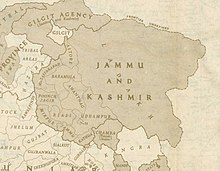| Gilgit Agency گلگت ایجنسی (Urdu) | |||||||||
|---|---|---|---|---|---|---|---|---|---|
| Agency | |||||||||
| 1889–1974 | |||||||||
 The Gilgit Agency at the northern periphery of Jammu and Kashmir (1946) | |||||||||
| History | |||||||||
| 1889 | |||||||||
• Gilgit Wazarat leased | 26 March 1935 | ||||||||
• Lease terminated | 30 July 1947 | ||||||||
• Gilgit rebellion | 1 November 1947 | ||||||||
| 19 November 1947 | |||||||||
• Merged into Northern Areas | 1974 | ||||||||
| |||||||||
| "A collection of treaties, engagements, and sunnuds relating to India and neighbouring countries" | |||||||||
The Gilgit Agency (Urdu: گلگت ایجنسی) was an agency within the British Indian Empire. It encompassed the subsidiary states of the princely state of Jammu and Kashmir situated along the northern border. The primary objective of establishing the Gilgit Agency was to bolster and fortify these regions, particularly in the context of concerns about Russian encroachment in the area.[citation needed] The subsidiary states encompassed Hunza, Nagar and other states in the present day districts of Gupis-Yasin, Ghizer, Darel, Tangir and Diamer. The agency headquarters was based in the town of Gilgit, within the Gilgit tehsil of Jammu and Kashmir.[a]
The administered area was bounded in the west by the Chitral State, in the northwest by Afghanistan's Wakhan corridor, in the east by Chinese Turkestan, in the south by the Kashmir province, and in the southeast by the Ladakh wazarat of Jammu and Kashmir (which included Baltistan).
An Officer on Special Duty was established in 1877 in the town of Gilgit, upgraded to a permanent Political Agent in 1889.[citation needed] In 1935, the Gilgit tehsil of the princely state was leased from the Maharaja, which also came under the administration of the Political Agent. The Astore tehsil continued to be under the Maharaja's administration. In July 1947, shortly before the partition of India, the Gilgit Leased Area and the Agency were returned to the Maharaja. However, the Gilgit Scouts rebelled on 1 November 1947 after the accession of Jammu and Kashmir to India, and Pakistan took over the administration of the areas soon thereafter.[1][2]
Under the Pakistani administration, the Gilgit, Astore, and Skardu (Baltistan) tehsils, as well as the subsidiary states previously under the agency, were clubbed together under the name of "Gilgit Agency". The unit remained in existence till 1974, after which it was abolished by the Pakistani Prime Minister Zulfiqar Ali Bhutto and turned into the Federally Administered Northern Areas (later renamed to "Gilgit-Baltistan").[3]
India continues to claim the entire region of Gilgit-Baltistan as part of the union territory of Ladakh.[4][5][6]
Cite error: There are <ref group=lower-alpha> tags or {{efn}} templates on this page, but the references will not show without a {{reflist|group=lower-alpha}} template or {{notelist}} template (see the help page).
- ^ Snedden, Understanding Kashmir and Kashmiris (2015).
- ^ Bangash, Three Forgotten Accesions (2010).
- ^ Ali, Nosheen (2019), Delusional States, Cambridge University Press, pp. 33–34, ISBN 978-1-108-49744-2
- ^ "Political Map of India".
- ^ "Govt releases new political map of India showing UTs of J&K, Ladakh". The Times of India.
- ^ "J&K Reorganisation (Removal of Difficulties) Second Order, 2019 -- [Territory of Leh district shall constitute, Gilgit, Gilgit Wazarat, Chilas, Tribal territory & 'Leh & Ladakh' except present territory of Kargil]". 2 November 2019.
© MMXXIII Rich X Search. We shall prevail. All rights reserved. Rich X Search
